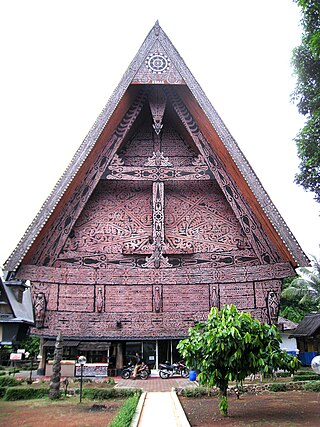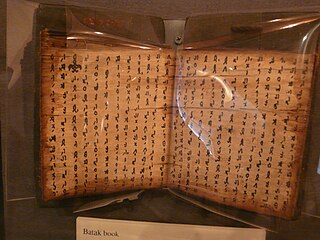The Batak script is a writing system used to write the Austronesian Batak languages spoken by several million people on the Indonesian island of Sumatra. The script may be derived from the Kawi and Pallava script, ultimately derived from the Brahmi script of India, or from the hypothetical Proto-Sumatran script influenced by Pallava.

Batak is a collective term used to identify a number of closely related Austronesian ethnic groups predominantly found in North Sumatra, Indonesia, who speak Batak languages. The term is used to include the Karo, Pakpak, Simalungun, Toba, Angkola, Mandailing and related ethnic groups with distinct languages and traditional customs (adat).

The Karo people are a people of the Tanah Karo in North Sumatra, Indonesia. The Karo lands consist of Karo Regency, plus neighboring areas in East Aceh Regency, Langkat Regency, Dairi Regency, Simalungun Regency, and Deli Serdang Regency. In addition, the cities of Binjai and Medan, both bordered by Deli Serdang Regency, contain significant Karo populations, particularly in the Padang Bulan area of Medan. The town of Sibolangit, Deli Serdang Regency in the foothills of the road from Medan to Berastagi is also a significant Karo town.

The Batak languages are a subgroup of the Austronesian languages spoken by the Batak people in the Indonesian province of North Sumatra and surrounding areas.

Toba Batak is an Austronesian language spoken in North Sumatra province in Indonesia. It is part of a group of languages called Batak. There are approximately 1,610,000 Toba Batak speakers, living to the east, west and south of Lake Toba. Historically it was written using the Batak script, but the Latin script is now used for most writing.
A tunggal panaluan is a magic staff used by shamans of the Batak people, who live in the highlands of North Sumatra, Indonesia. Traditionally the tunggal panaluan is made from wood of a specific tree and carved with human figures and embellished with horsehair and cooked human brain, both procured from sacrificial victims.

The Simalungun people are an ethnic group in North Sumatra, considered one of the Batak peoples. Simalungun people live mostly in Simalungun Regency and the surrounding areas, including the city of Pematang Siantar, an autonomous city, but previously part of Simalungun Regency.

Patuan Bosar SinambelaginoarOmpu Pulo Batu, better known as Si Singamangaraja XII, was the last priest-king of the Batak peoples of north Sumatra. In the course of fighting a lengthy guerrilla war against the Dutch colonisation of Sumatra from 1878 onwards, he was killed in a skirmish with Dutch troops in 1907. He was declared a National Hero of Indonesia in 1961 for his resistance to Dutch colonialism.

The Toba Batak people are the largest ethnic group of the Batak peoples of North Sumatra, Indonesia. The general term ‘Batak’ is sometimes used to refer to the Batak Toba people, for one thing because the Toba people are the largest sub-group of the Batak ethnicity, for another because they tend to self-identify as merely Batak instead of ‘Toba’ or ‘Batak Toba’, contrary to the habit of the Karo, Mandailing, Simalungun, Pakpak communities who commonly self-identify with their respective sub-groups.

Batak architecture refers to the related architectural traditions and designs of the various Batak peoples of North Sumatra, Indonesia. Six groups of Batak speak separate but related languages: the Angkola, the Mandailing to the south, the Toba, to the north the Pakpak/Dairi, the Simalungun, and the Karo. While the groups are now Muslim or Christian, elements of the ancient Batak religion remain, particularly amongst the Karo.

Batak cuisine is the cuisine and cooking traditions of Batak ethnic groups, predominantly found in Northern Sumatra region, Indonesia. Batak cuisine is part of Indonesian cuisine, and compared to other Sumatran cuisine traditions, it is more indigenously preserved. One characteristic of Batak cuisine is its preference to andaliman as the main spice. That is why andaliman in Indonesia sometimes dubbed as "Batak pepper".

Boraspati ni Tano or Boraspati, also known as Ilik, is the earth deity in Batak mythology. Boraspati ni Tano is represented as a tokay gecko. Images of Boraspati can be found decorating the door of a Batak Karo and Batak Toba buildings as well as other Batak objects e.g. the cover of the pustaha or the pupuk container naga morsarang.

A sopo is a treasury structure in the architecture of the Toba Batak people from North Sumatra, Indonesia. Its form is similar to that of a Batak traditional house with the exception of being smaller in size and a construction ritual that is the opposite of a Batak house. Sopo is used as a repository for various items, e.g. rice, magical items, or trophies. Sopo can also be used as a meeting point for social activities.

The Great Pustaha is a pustaha displayed in the Tropenmuseum of Amsterdam. The name refers to the largest pustaha which was kept in the museum. The official name for the pustaha is simply "pustaha", but for the purpose of distinction, the pustaha is called the Great Pustaha.

Pustaha is the magic book of the Batak people of North Sumatra, Indonesia. The book contains magical formulas, divinations, recipes, and laws. The pustaha is written and compiled by a Batak magician-priest (datu).

Gorga is a form of artistic decoration found in the culture of Batak Toba in North Sumatra, Indonesia. The gorga motif is in the shape of flourishes and undulations. The motif is either painted or carved onto wood using three colors: white, red, and black; each corresponds with different realms in the Batak Toba cosmology. The Gorga motif is often found in Batak Toba architecture, e.g. a Batak Toba house, or objects, e.g. music instruments. They are meant to protect the building or object from spiritual harm, e.g. evil spirits sent from neighboring village.

The naga morsarang, also known as sahan, is a container which is used to store medicine in the culture of Toba Batak people of North Sumatra, Indonesia. The naga morsarang is created out of the horn of the water buffalo.
The Porhalaan is the traditional calendar of the Batak people of North Sumatra, Indonesia. The Batak Calendar is a lunisolar calendar consisting of 12 months divided to 30 days with an occasional leap month. The Batak calendar is derived from Hindu calendar. The Batak people do not use the porhalaan as a mean to tell time, but rather to determine auspicious day, which is only used by the Batak shaman.

Batak mythology is the original belief that was once adopted by the Batak people of North Sumatra, Indonesia, namely before the arrival of Protestant, Catholic, or Islamic religions. There are various tarombo versions written on pustaha which historians study, but generally refer to the figures below.

Tortor is a traditional Batak dance originating from North Sumatra, Indonesia. This dance was originally a ritual and sacred dance performed at funerals, healing ceremonies, and other traditional Batak ceremonies. For the Batak people, tortor dance has both cultural and spiritual values. Through this dance, people express their hopes and prayers. Demonstrations of attitudes and feelings through this dance describe the situation and conditions that are being experienced.

















